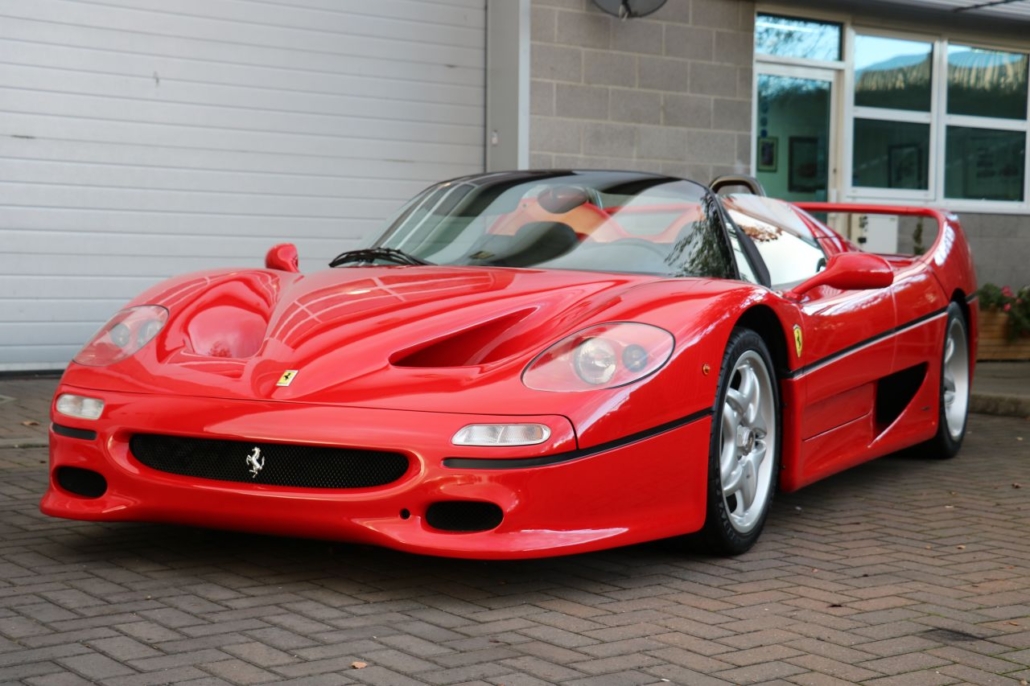Ferrari F50
Created to celebrate Ferrari’s 50th anniversary, the F50 was the closest thing to a road-going Formula 1 car the company had ever built. Given its uncompromising, purist approach to high performance, the F50 was devoid of power steering, power assisted braking and ABS, but made extensive use of sophisticated composite materials, F1-style construction technology and aerodynamics.
Whereas the two previous “Supercars” had been powered by turbocharged V8 engines, the nineties variant used a normally aspirated V12 engine as the motive force, albeit more than fifty per cent greater in capacity than its predecessors. Similarly the earlier models had introduced increasing degrees of technology learned from the Formula One cars, particularly in the field of composite materials. The Pininfarina styling didn’t have the raw beauty of the F40, and bore little in common with any other Ferrari model, apart from the satin black finished side indent line and traditional paired rear light treatment. It had plenty of curves, intakes and exhaust slots, and an even more radical rear wing than the F40, but the body shape was more one of aerodynamic function than aesthetic pleasure. It did have a removable hardtop, so that the occupants could come even closer to the F1 experience.
The mid mounted engine was a 65 degree V12 unit fitted longitudinally and rigidly mounted to the rear bulkhead of the monocoque cell. A lightweight nodular cast iron block was used that featured integral Nikasil coated cylinder liners, whilst the connecting rods for the special forged alloy pistons were manufactured from titanium alloy. The bodies were mounted on a 2580mm wheelbase chassis, with a 1620mm front track and 1602mm rear track. The Cytec Aerospace carbon fibre chassis had factory reference numbers F 130 BD, and were numbered in the continuous chassis number road car sequence. The construction incorporated the rubber fuel cells within the structure between the passenger compartment and engine mounting points, and as with the F40 the body panels were all constructed from composite materials. There was a more generous choice of colour options on the F50, than on the “red only” GTO and F40, with clients having a choice of five colours to chose from, two different shades of red, yellow, black and silver, most opting for the racing red scheme.
Once again a USA market version was produced, and as with the previous two “supercars”, all market models were left hand drive.
Ferrari F50 Technical Specifications
Year of Manufacture – 1995
| ENGINE | ||
| type | rear, longitudinal 65° V12 | |
| bore/stroke | 85 x 69 mm | |
| unitary displacement | 391.54 cc | |
| total displacement | 4698.50 cc | |
| compression ratio | 11.3 : 1 | |
| maximum power | 382 kW (520 hp) at 8500 rpm | |
| power per litre | 111 hp/l | |
| maximum torque | 471 Nm (48 kgm) at 6500 rpm | |
| valve actuation | twin overhead camshafts per bank, five valves per cylinder | |
| fuel feed | Bosch Motronic M2.7 injection | |
| ignition | Bosch Motronic M2.7 electronic static, single spark plug per cylinder | |
| lubrication | dry sump | |
| clutch | twin-plate | |
| CHASSIS | ||
| frame | carbon-fibre monocoque | |
| front suspension | independent push-rod, unequal-length wishbones, coil springs, gas-filled telescopic shock absorbers | |
| rear suspension | independent push-rod, unequal-length wishbones, coil springs, gas-filled telescopic shock absorbers | |
| brakes | discs | |
| transmission | 6-speed + reverse | |
| steering | rack-and-pinion | |
| fuel tank | capacity 105 litres | |
| front tyres | 245/35 ZR 18 | |
| rear tyres | 335/30 ZR 18 | |
| BODYWORK | ||
| type | two-seater berlinetta and spider | |
| length | 4480 mm | |
| width | 1986 mm | |
| height | 1120 mm | |
| wheelbase | 2580 mm | |
| front track | 1620 mm | |
| rear track | 1602 mm | |
| weight | 1230 kg (dry) | |
| PERFORMANCE | ||
| top speed | 325 km/h | |
| acceleration 0-100 km/h | 3.87 sec | |
| 0-400 m | – | |
| 0-1000 m | 21.70 sec | |

